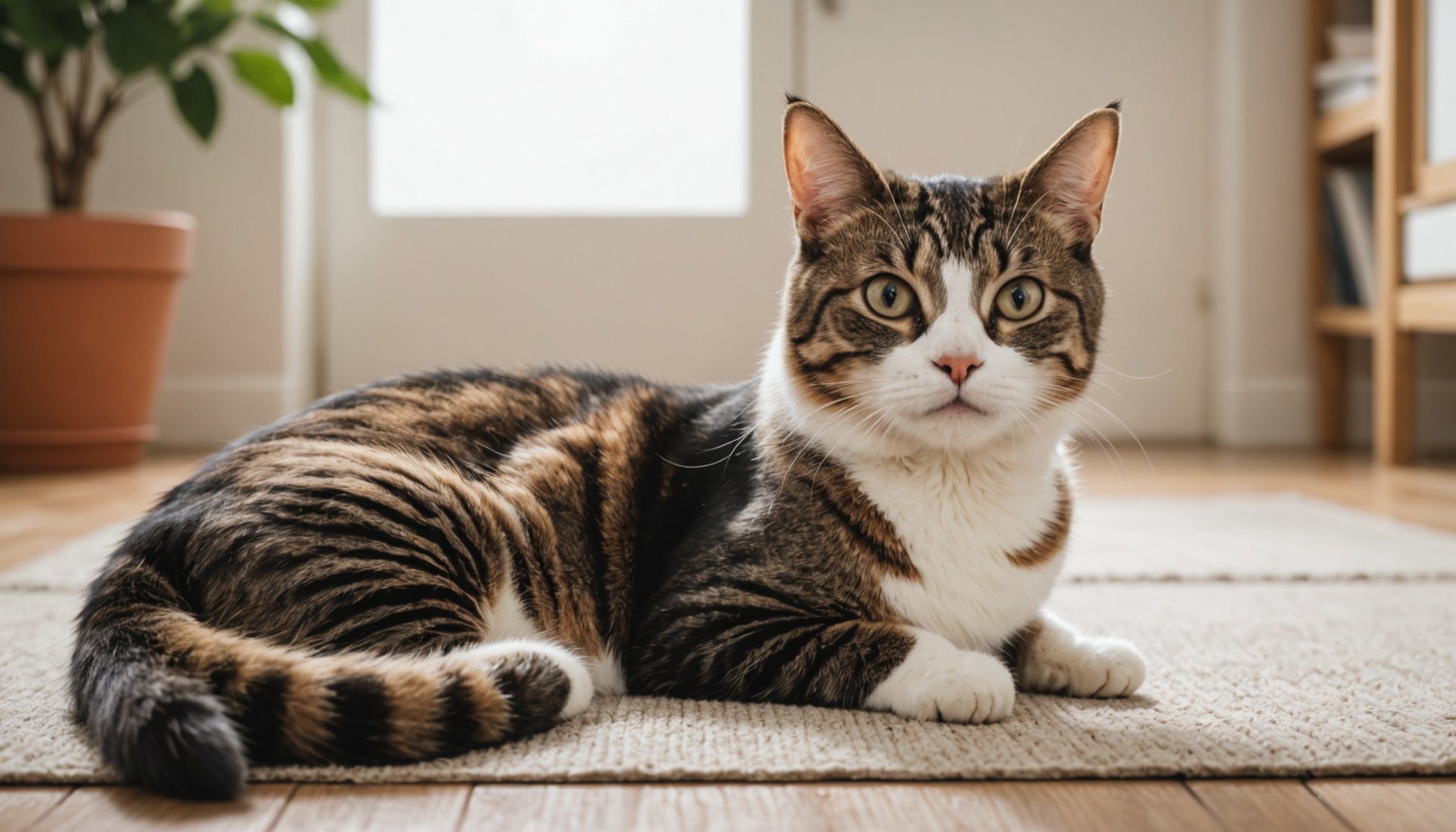Understanding Feline Anxiety
Anxious cats can express their unease in diverse ways, and it is crucial to recognise the individual cat behaviors that indicate distress. Common signs of feline anxiety include excessive grooming, hissing, or even withdrawal. These are often telltale signs that your feline companion is feeling stressed.
Several factors contribute to anxiety in cats, such as changes in their environment, introduction of new pets or family members, or even their routine experiencing disruption. It’s imperative to consider these aspects to better understand the root causes of their anxiety.
In the same genre : Top Strategies for Seamlessly Introducing a Senior Cat to a New Kitten
Understanding the nuances of your own cat’s behaviour and how they communicate their feelings is essential. Some cats might act out by scratching furniture or urinating outside the litter box when anxious. Observing these patterns can help you zero in on what might be triggering their discomfort, thus aiding in implementing the appropriate interventions.
Recognising individual cat behaviors amidst common signs of stress can enable more tailored solutions for them. Addressing feline anxiety can encompass creating a secure environment, providing consistent routines, and integrating behavioural therapy if needed. Each cat is unique, and understanding these intricacies can significantly improve their well-being.
This might interest you : Ultimate guide to providing exceptional care for cats with feline lower urinary tract disease (flutd)
Key Elements for a Calm Space
Creating a calm environment begins with selecting the right colours and materials. Soft, calming colours such as pale greens, blues, and neutral tones can transform walls and furnishings into a serene backdrop. These hues not only soothe the mind but also support relaxation, making your space an oasis of tranquillity.
Incorporating soothing materials is essential. Opt for flooring like cork or bamboo that are not only resilient but also gentle underfoot, muffling noises and enhancing comfort. Plush, tactile textiles, including layered rugs and soft throws, lend warmth while adding layers of texture. These elements encourage moments of calm reflection and provide tactile pleasure.
Choosing a cat-friendly decor approach ensures your feline companions also benefit from the serene atmosphere. Consider multi-level cat trees and plush bedding that complement your decor, all while meeting the needs of your furry friends.
Minimizing distractions is crucial for maintaining a peaceful environment. Implementing noise reduction techniques, such as heavy curtains, area rugs, and acoustic panels, can significantly reduce external sounds. This not only enhances relaxation but also helps in creating an undisturbed space perfect for mindfulness and focus.
Creating Safe Hiding Spots
Every cat deserves a place where they can feel secure and comfortable. Hiding spots, such as cat caves or secure spaces, offer a retreat when cats need solitude.
Utilizing Furniture for Hiding
Furnishings in your home can be repurposed to create inviting hiding spots. Deep shelves or the space beneath a sofa can become secure spaces for cats to relax. To enhance these areas, use soft materials and ensure they remain undisturbed. It’s important that these spots are sufficiently dark and cozy, providing a sense of shelter from the hustle and bustle of daily life.
DIY Hiding Spaces
You can easily craft DIY hiding spaces using household items. A cardboard box or an old suitcase can be transformed into a simple yet effective hiding spot. Line them with blankets or soft fabric to make them inviting. These cat caves can be personalized to suit your pet’s preferences, making them an ideal haven for rest and relaxation.
Off-the-ground Options
Consider elevated hiding spaces to add a new dimension of safety for your cat. Cats often feel more secure when they observe their environment from higher vantage points. Utilize vertical spaces by providing shelves or perches, which can serve as ideal hideaways for anxious cats. Such arrangements promote a sense of security, allowing them to watch the world from a safe distance.
Sensory Enrichment for Relaxation
Providing your feline friend with sensory enrichment can significantly enhance their relaxation. One such method is incorporating calming scents into their environment. Scents such as lavender or chamomile can have a soothing effect, thanks to their natural relaxing properties. These can be introduced through diffusers or scented toys designed specifically for cats.
Selecting the right cat toys is also crucial in promoting mental engagement. Interactive toys that challenge your cat’s mind keep them stimulated and content. Puzzle feeders, for example, not only engage your cat’s senses but also satisfy their hunting instincts, providing both entertainment and relaxation.
To further support relaxation, consider establishing a dedicated area for safe exploration and play. This space should be free from hazards while offering various textures and heights to climb, scratch, and nap. This way, your cat can express its natural behaviours without stress, contributing to overall well-being.
By integrating these elements into your cat’s environment, you are helping to create a balanced space that caters to their sensory and emotional needs. Such enrichment not only fosters relaxation but also encourages a harmonious relationship between you and your pet.
Vertical Spaces for Security
When it comes to enhancing feline comfort, cat trees, shelves, and climbing structures play a pivotal role. These vertical solutions offer cats a safe haven to retreat, observe, and explore from an elevated perspective.
Types of Vertical Solutions
Offering a range of options, cat trees are multi-tiered structures designed to mimic a cat’s natural environment. Climbing shelves, when mounted on walls, provide a streamlined look while maximising space. Other innovative solutions include modular climbing structures, which can be tailored to suit your home’s aesthetic and accommodate multiple cats simultaneously.
Strategic Placement of Vertical Spaces
The positioning of vertical spaces is critical. Ideally, structures like cat trees and shelves should be placed in areas where cats can access favourite spots with ease, such as near windows or in rooms where family members congregate. This strategic placement allows cats to feel a sense of belonging while maintaining a watchful eye on their surroundings.
Benefits of Height for Anxious Cats
For cats with anxiety, vertical spaces are transformative. These elevated areas provide a sense of security and control, enabling cats to retreat from potential stressors and survey their domain. The psychological relief afforded by climbing structures promotes calmness and reduces stress-related behaviours, enhancing overall well-being.
Recommended Products for Anxious Cats
Anxious cats can benefit greatly from carefully selected calming products and cat furniture. These specialized items are designed to support feline anxiety relief, providing a sense of security and comfort.
Consider incorporating calming diffusers into your home. Brands like Feliway offer products that release synthetic facial pheromones, mimicking the natural way cats mark safe spaces. These products are known to help reduce stress-related behaviors such as scratching and marking. Soft, comfortable beds can also serve as a retreat for anxious cats, and brands like PetFusion provide high-quality options that are both supportive and snug.
When selecting cat furniture, consider products that offer not only physical comfort but also mental stimulation. Cats love to explore, scratch, and perch, so a multi-level cat tree can be ideal. Vesper and Frisco make sophisticated designs that integrate all these features, allowing your feline friend an outlet for energy and anxiety.
It’s crucial to tailor these products to your cat’s specific needs. Pay attention to the materials used, the durability, and how well they complement your cat’s natural instincts. Investing in the right accessories can significantly enhance your cat’s well-being, promoting a peaceful and harmonious home environment.
Monitoring and Adjusting the Environment
Creating a calming environment for your feline friend involves both behaviour monitoring and space adjustment. It’s crucial to observe how your cat reacts to changes in its surroundings. Look for signs of comfort or discomfort, like purring or hiding, respectively. These reactions are indicators of your cat’s feelings towards the environment.
Once you’ve identified how your cat is responding, make gradual adjustments to better suit its needs. This might mean adjusting the lighting, altering the positioning of furniture, or introducing new, calming elements like soft blankets or toys. It’s best to introduce changes slowly to avoid overwhelming your cat.
Cat comfort should remain a priority in all these adjustments. Ask yourself questions like: Is my cat using the newly designated space? Is it returning frequently? By ensuring these spaces are inviting and stress-free, you can improve your cat’s overall well-being.
It’s also important to continually assess the environment. Regular evaluations allow you to enhance the calming space as your cat’s preferences change. Adaptations can include rotating toys, changing scents, or simply keeping the area clean and fresh, ensuring your feline feels at ease every day.











